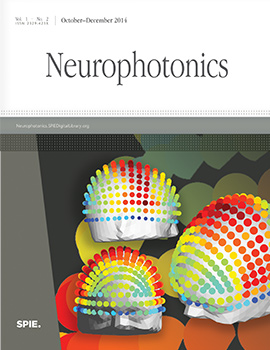Paolo Giacometti, Solomon Diamond
Neurophotonics, Vol. 1, Issue 02, 025001, (September 2014) https://doi.org/10.1117/1.NPh.1.2.025001

TOPICS: Electroencephalography, Near infrared spectroscopy, Electrodes, Brain, Sensors, Head, Point spread functions, Tissue optics, Monte Carlo methods, Diamond
This study investigates the correspondence of the cortical sensitivity of electroencephalography (EEG) and near-infrared spectroscopy (NIRS). EEG forward model sensitivity to the cerebral cortex was calculated for 329 EEG electrodes following the 10-5 EEG positioning system using a segmented structural magnetic resonance imaging scan of a human subject. NIRS forward model sensitivity was calculated for the same subject using 156 NIRS source-detector pairs selected from 32 source and 32 detector optodes positioned on the scalp using a subset of the 10-5 EEG positioning system. Sensitivity correlations between colocalized NIRS source-detector pair groups and EEG channels yielded R=0.46±0.08 . Groups of NIRS source-detector pairs with maximum correlations to EEG electrode sensitivities are tabulated. The mean correlation between the point spread functions for EEG and NIRS regions of interest (ROI) was R=0.43±0.07 . Spherical ROIs with radii of 26 mm yielded the maximum correlation between EEG and NIRS averaged across all cortical mesh nodes. These sensitivity correlations between EEG and NIRS should be taken into account when designing multimodal studies of neurovascular coupling and when using NIRS as a statistical prior for EEG source localization.



 Receive Email Alerts
Receive Email Alerts